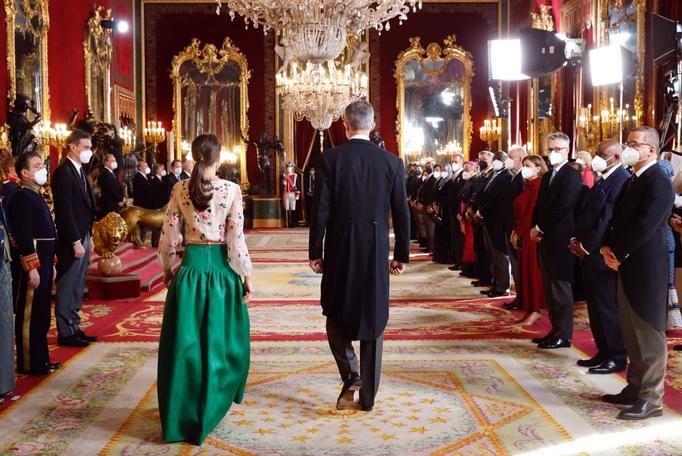Letizia, the Valentino of Queen Sofía and the curious story of the Molinero sisters
Yesterday morning and following the calendar of every year, the King and Queen staged one of the most solemn acts that take place in the Royal Palace: the reception to the Diplomatic Corps accredited in Spain. It is the moment when the King usually delivers one of his most politically significant speeches —it is where he outlines Spain's international policy lines for the coming years—, but all the spotlights tend to focus on what Letizia is wearing. Well, let's break the habit and talk about what the King has said. Then we deal with Letizia.
This year, the King gave a good speech —long and with convoluted sentences, but much better written and with more substance and concreteness than other years. Above all, he reached out to Morocco, a country with which we have not gotten along very well - let's say it delicately - in recent times. “With Morocco,” said King Felipe VI, “our respective governments have agreed to jointly redefine a relationship for the 21st century, on stronger and more solid pillars. Now, both nations must walk together to begin to materialize this new relationship." Significant, very significant. And more taking into account that in the speech he did not name Algeria at any time (he did speak of the Maghreb). There are silences that speak for themselves.
Letizia and the recycled wardrobe
Let's move on to Letizia. Now this recycling of clothes is very popular —that's why you have to be sustainable— and we have seen a multitude of princesses rummage through the closet of their grandmothers and mothers to rescue from oblivion costumes that were previously called old and have now acquired the title more vintage worthy. Without going any further, the princesses of Sweden Victoria and Magdalena frequently appear in public with dresses that their mother wore decades ago. And Princess Beatrice of York herself, daughter of Prince Andrew and granddaughter of Elizabeth II of England, chose for her very wedding a suit from her sovereign grandmother decades ago.
Letizia has also signed up for this look in the wardrobe and has already appeared in public with three models that belonged to Queen Sofía, her mother-in-law. The first time was in January 2018, when the Royal House released a photograph of the royal family celebrating Juan Carlos' 80th birthday and we saw Letizia in a gray dress with fine stripes and a tie that Sofia had worn in 1984. The second time was in December 2018, when Letizia presided over the National Fashion Industry Awards ceremony and appeared in a red suit that Sofía had worn for the first time on an official trip to Denmark back in November 1984.

The third one was yesterday. Letizia wore a dress – made by the Molinero sisters following Valentino patterns – that Queen Sofía wore for the first time in 1977 on an official trip to what was then the Federal Republic of Germany. It consisted of a wide skirt in bottle green with a high waistband, and a body with a kind of blouse with—beautiful—embroidered flowers and wide sleeves. In Sofia's case, the look was completed with a discreet bow at the waist. Letizia has removed the bow.
And the spectacularity of the suit, we can say. You can tell that the materials are very good and that the pattern is impeccable —and, I insist, the embroidery of the flowers is exquisite—, but the suit did not look good. Or it didn't look as bright as it should. To begin with, neither the color nor the shape were appropriate for a mid-January event. Second, the dress did not fit Letizia's body well, especially the skirt. That waistband —so typical of Valentino's designs in the eighties— requires much more height and also a little more corpulence. Besides, those blouses with transparent sleeves and embroidery that Letizia insists on wearing —she has some Carolina Herrera dresses that follow that pattern— do not work for her.
The Queen has serious problems finding formal gowns that suit her at morning functions (with notable exceptions: the other day, at Military Easter, she was beaming in that metallic blue suit). In addition, Letizia continues to have a problem for years: the costumes dress her and not the other way around. They outshine her. Many things can be said about Queen Sofía, of course, and not always good, but she knew how to wear ball gowns like no one else. In her day-to-day life she was somewhat gray and classic, but on grand gala occasions she was sublimely elegant, majestic. You really saw a Queen.
Queen Sofía knew, as all truly elegant ladies know, that you have to find your own style (don't copy anyone), always look appropriate and, above all, bet on suits that fit your body well. Let them enhance you and hide your defects.
Sofía knew this and, therefore, surrounded herself with true professionals. Letizia may have a stylist, but Sofia had two much better women: the Molinero sisters.
The history of the Molinero sisters
Although their names are not known outside of high society, Pilar and Maria Antonia Molinero, the Molinero sisters, as they were called, have been two of the creators who more have been done for haute couture in Spain.
First from their workshop on Paseo de la Castellana and then from the one they opened on Ayala street (and, more recently, on Fortuny street), they were the ones who, at a time when boutiques like the ones did not exist, we know today and encouraged by their friend the master Balenciaga —who called them “little girls”—, they began to bring the creations of the best foreign couturiers. They bought the sketches in Paris and Milan and sewed them themselves —with the authorization of the maisons— in Spain. Thanks to them, the good ladies of Madrid were able to wear Yves Saint Laurent, Lacroix and Oscar de la Renta. And, above all, wearing evening dresses —“fantasy”, as they called them— from Valentino, for whom they felt a special devotion.
Very professional, exponent of impeccable savoire faire and with sublime manners, the Molineros were so discreet that not only did they never grant an interview, but when María Antonia died on June 24, 2019, her obituary did not appear on ABC until almost three months later. However, despite the silence that characterized them, the Molinero surname will always be linked to the most elegant women, from Paloma O'Shea (widow of Emilio Botín) to María José Guil (widow of Isidoro Álvarez, the president of the El Corte group). English), Button Dove or Conchita de la Lastra.
Doña Sofía, of course, did not overlook the enormous talent of those highly educated sisters, very pretty and with exquisite taste (something innate, which cannot be bought with money). In the Molinero workshop, everything was done by hand, in an artisanal way, thinking about each piece and giving great importance to every detail. Pilar was the one in charge of the "proportions", of drawing the suit thinking of the body of each client. Every pattern and cut was thought to flatter. She was a born perfectionist: she insisted on fitting until the dress was flawless. Maria Antonia focused on what we now call "look", that the set works. She was the one who chose the accessories and even suggested hairstyles and makeup.
If they had known that Letizia wanted to opt for one of their creations, they would surely have recommended a totally different style of dress. And they would have done it with that kind subtlety of whom she has real class.









